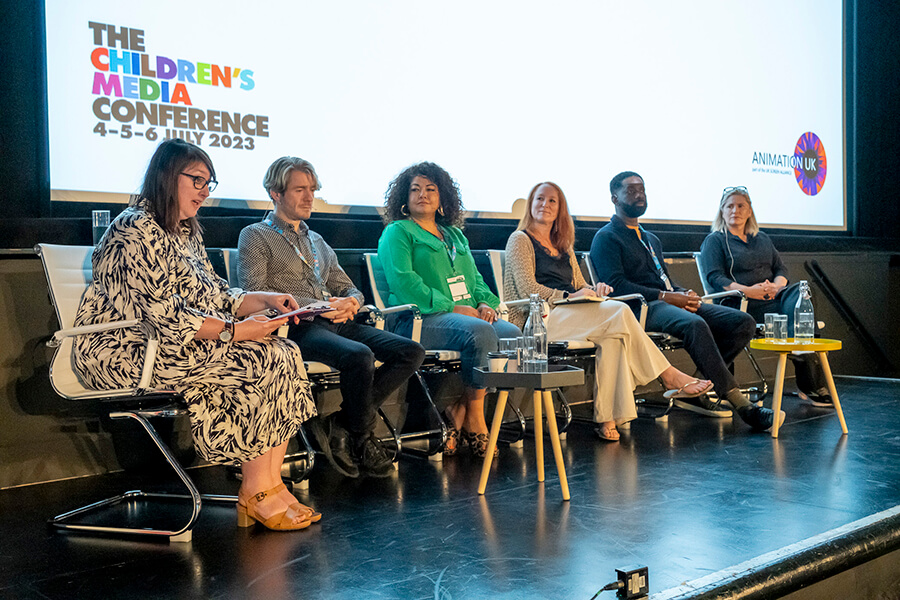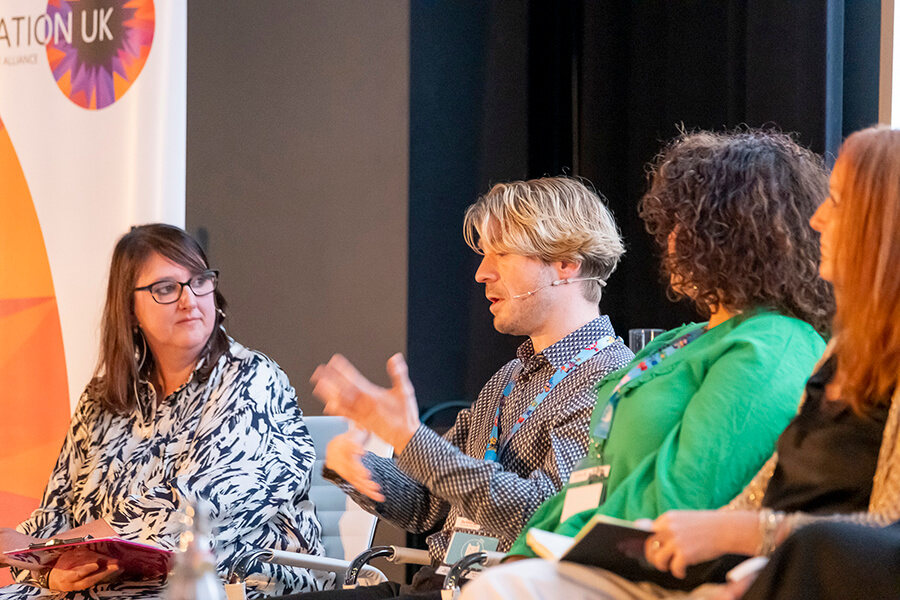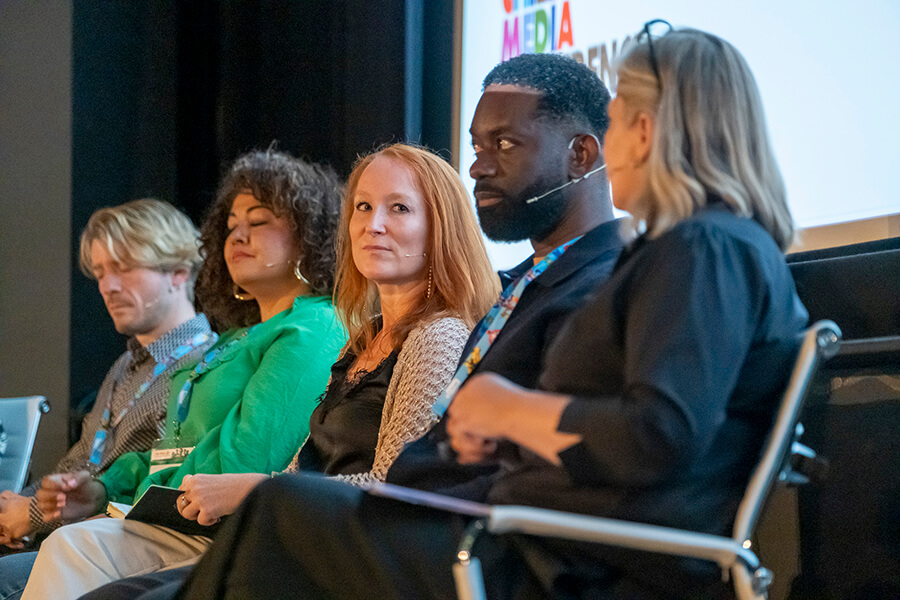Children’s Media Conference 2023: Animation Assemble Recap

Animation Assemble panel (Image source: Children’s Media Conference – iD8 Photography)
For those who may not know, The Children’s Media Conference is one of the biggest events in the UK for those who work across the media industry to create new content for young audiences. Whether they are major broadcasters from the BBC and Sky, writers for publications and episodes of beloved children’s television, or students wanting to learn what a wide variety of studios are developing, everyone gathers in Sheffield to enjoy pitching, networking, and learning in one brilliant week.
And this year, there was plenty to discuss when it came to animation within the UK. Those who attended this year were able to learn the developmental process from Aardman Animations and treated to some first looks at upcoming projects (Wallace & Gromit’s upcoming production excluded, unfortunately.) But there was also the session titled Animation Assemble that saw the director of the British Animation Awards, Helen Brunsdon, hosting a panel made up of producers and directors from some of the biggest UK broadcasters and major global brands. Learning a lot about their perspectives on the new challenges that producers will face and how to continue making homegrown content, we wanted to share our biggest takeaways from what they had to say with our readers.
New Platforms, New Opportunities?
“Our industry is constantly evolving.” That was the Director of Kid’s Content at Sky’s Lucy Murphy’s response when she and the panel were asked if new platforms could create new opportunities for IPs by Helen. Sky Kids launched a linear channel to co-exist next to the existing app and streaming service that Sky provides for its young audience and give more opportunities for them to find new content, whether animated or live-action.
Streaming has clearly changed the way everyone consumes and watches content, but it also created important normality when it comes to representation as well as giving creators a global platform. Edward Barnieh, Vice President of Development at BBC Studios Kids & Family, explained how a need to represent everyone changed when the “boom of streaming” came about. While many streaming services now exist in the market, new and existing IPs have been able to represent and show everyone and anyone in a way not previously seen across the globe.
But despite the opportunities that Lucy and Ed explained, it can also be more challenging for new voices to be heard and is “increasingly harder to do” according to Courtney Arumugam. The London-based Executive Producer at LEGO said that new ideas and concepts for the famed toy company are to be likely received from existing IPs and with them manufacturing sets based on major franchises like Jurassic World and Star Wars, it’s not hard to see the obstacles and challenges from new voices who may want to create an original or fresh idea.
Challenges in Wales

Jon Rennie speaking on the Animation Assemble panel (Image source: Children’s Media Conference – iD8 Photography)
Jon Rennie, Managing Director of the Welsh-based studio Cloth Cat, had a fascinating answer when asked about the recent tax relief uplift for UK animation and if it has successfully lined up with international competitors from his perspective.
He explained that studios in Wales were seen as a training ground for new and emerging animators to eventually work for bigger studios across the UK. Despite the Welsh Government offering ten per cent for spending, it’s something that looks great, but Jon wanted to see more build-up for “Welsh companies and not parachute anything in.” And with the impact of the pandemic, he admitted that it’s been hard to keep jobs going with people adapted to remote or hybrid working.
Adding onto this insight, Jon also told the audience how challenging it is for smaller production companies to regain the money they invested in. “We’re the ones taking the risk” when it came to his perspective on funding for animation as he felt that the production companies reinvested more into a project than the broadcaster put in with little to no promise of ever seeing the money return.
Reboots and Revamps
Continuing the discussion of existing IPs, Lucy and Courtney discussed the importance of revamping older brands for a whole new generation to discover and explore. It’s certainly something that the animation industry has seen used effectively well this year so far with a brand new take on the heroic Puss in Boots from the Shrek franchise, a Star Wars series aimed exclusively at pre-schoolers with Young Jedi Adventures, and Super Mario Bros. stepping out of the video game market and breaking cinematic box office records like a Question Block.
Seeing “something known in a different way” seems to be the key according to Courtney and is an easier way for rights holders and producers to take risks and make bold decisions. Spider-Man: Across the Spiderverse is very much a brilliant example of what Courtney shared with the audience as not also did it introduce new diverse heroes from the popular Marvel comics in the leading roles, but expanded the gorgeous and stylized designs that made it one of the most visually unique titles released for the summer.

on the Animation Assemble panel (Image source: Children’s Media Conference – iD8 Photography)
Supporting Skills and Diversity in the Workplace
Jellyfish Animation & Originals’ Managing Director, Natalie Llewellyn, admitted that as an industry, “we’re doing an ok job but we could do better” when it came to Helen asking the panel about how we could support skills in diversity. The studio tries to support schools and universities through internships, panels, live discussions, etc. Talent needs to be nurtured and given the proper career progression and trajectory so that these particular individuals can stay with them.
Natalie explains the hardships that women in particular can have when they exit the industry for a number of reasons regardless of the situation and try to return to work in animation. Opportunities like ‘return-ships’ or going into a new entry point in the industry are just some ways that this could help improve the chance for women to resume their careers or try a new approach that isn’t just simply animating.
Being part of a huge broadcaster like Sky, Lucy opened up that they have been able to create access points like Sky Academy, which allows schools to visit the various studios and have the exciting opportunity to create a piece of content too. It gives children an insight into the media industry while also encouraging them to potentially get involved when they grow up. However, when it comes to the targets of diversity within animation, they have found it difficult to do so. Lucy suggested that hiring a head of production that reflects the audience they are aiming at could help them reach these targets more effectively.
Sociodiversity is also a concern for those trying to break into the industry within Britain alone. Ed shared with everyone the story of how he was able to break into the media industry with an internship he secured at Nickelodeon but was only able to do so because he lived with his family in London. Many students and potential employees get “wowed” by the industry and its exciting world, but many get a “reality check” and as a result, the studios end up losing precious people in the process.

Animation Assemble panel (Image source: Children’s Media Conference – iD8 Photography)
While education is important for those who want to learn and obtain the vital skills for working in multiple creative industries, some things should be altered for those who are especially studying animation. Jon expressed, however, that he felt that dissertations were not perhaps the best way for graduates to demonstrate their skillset, explaining that he prefers to see the work they have accomplished rather than reading about the experiences that they have acquired.

